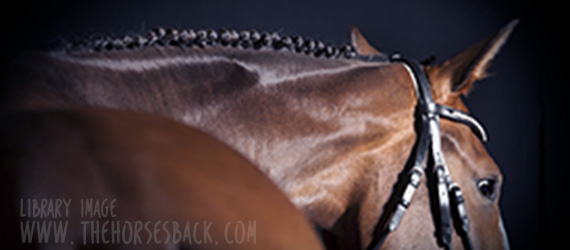
“I went through three years of horror…”
So speaks a Warmblood owner, reflecting upon a truly dreadful period in her life. Like many other owners, she has gained belated understanding of her horse’s problems after reading about research findings into the C6-C7 malformation (article) led by Australian gross anatomist, Sharon May-Davis.
Sadly, this is a bittersweet moment: there is a temporary relief as everything finally makes sense, yet with it comes the realisation that there is nothing that can be, or could have been, done for a treasured horse bearing the more extreme version of this malformation.
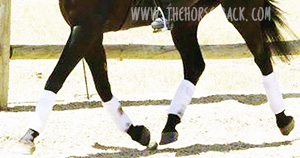 Here, Diana from Michigan, USA, gives her story of the desperation and – ultimately – heartache she experienced when trying to find out what was wrong with her horse of a lifetime, a young Oldenburg gelding, “the kindest horse I ever had”.
Here, Diana from Michigan, USA, gives her story of the desperation and – ultimately – heartache she experienced when trying to find out what was wrong with her horse of a lifetime, a young Oldenburg gelding, “the kindest horse I ever had”.
Note: We are not identifying the lines of the individual horse in this story. If you’re thinking we should, perhaps remember that it’s a litigious world out there.
But for now, over to Diana.
© All text copyright of Jane Clothier, www.thehorsesback.com. No reproduction of partial or entire text without permission. Sharing the link back to this page is fine. Please contact me for more information. Thank you!
Diana’s Story
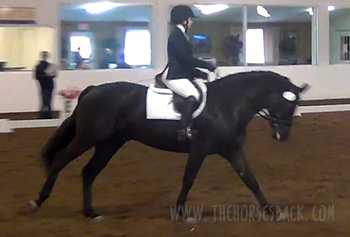 I purchased a stunning 3-year-old Oldenburg to fulfill my dream of developing a young horse through the upper levels in dressage. I cashed in the 401K [retirement savings plan] for the horse and bought a Schleese saddle.
I purchased a stunning 3-year-old Oldenburg to fulfill my dream of developing a young horse through the upper levels in dressage. I cashed in the 401K [retirement savings plan] for the horse and bought a Schleese saddle.
For the first two years (ages 3 and 4) we were champion every time out.
At age 5, however, my trainer noticed he began to drag his left hind toe. Then his impulsion began to deteriorate, and months later he became too unstable to safely handle. He was euthanized at 7 years old.
Looking back, I now believe that all his quirks were directly related to this problem. I am going to briefly list the oddities I experienced with this wonderful horse.
I am not a vet or tech, and am only sharing my experiences in the event that it may help someone else, because my journey was one of the most emotionally draining experiences in my life.
Possible Signs of this Warmblood’s C6-C7 Problem
I purchased my gelding on his 3rd birthday and he’d had 30 days under saddle. The oddities of my gelding: he was extremely sweet and willing – the kindest horse I ever had.
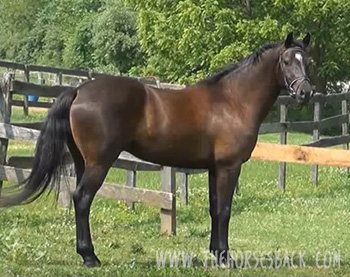 He required a tremendous amount of leg every step. Although there seemed to be no ‘self-carriage’, I attributed this to his being green and still learning.
He required a tremendous amount of leg every step. Although there seemed to be no ‘self-carriage’, I attributed this to his being green and still learning.
He would buck EVERY TIME he was saddled (I was very conscientious about slowly tightening the girth, tried every type of girth, pads, had adjustable saddle, etc).
Again, I attributed the bucking to youthfulness, and would let him buck out for a few laps, and then wondered if I had created a habit, because this occurred every schooling.
- If he wasn’t lunged first, he would explode into a non-rideable rodeo with absolutely no warning.
- He had a very difficult time bending to the left – he would try, but would drift.
- Two separate times after mounting at the block, he felt like he arched or sucked his back up about 3 inches before walking off.
- After 25 mins of schooling he would start rooting at the reins, or if the lesson was a short one, as soon as I’d give him his head to cool out.
- He was a stumbler – not often – again, I attributed it to youth.
- He could not be shod or trimmed without being sedated.
- Once, a friend said it looked like he couldn’t put his head down to reach hay. Of course, I thought she was nuts until I witnessed it first hand.
Questions, thoughts or comments? Join us at The Horse’s Back Facebook Group.
Investigating the C6-C7 Problem
During my discovery phase, he was diagnosed with moderate PSSM. So, he and I spent 9 months testing sugar levels in hay, with turnout in a dry lot.
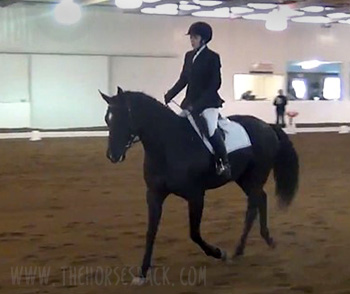 There were periods he would barely walk forward when leading, and at the time I thought he was tying up, but it didn’t seem like what I had read, and I have never witnessed a horse tying up.
There were periods he would barely walk forward when leading, and at the time I thought he was tying up, but it didn’t seem like what I had read, and I have never witnessed a horse tying up.
Then in his latter days, his neurological issues became more obvious with each passing day.
I did have a myelogram done on him, and it revealed compression of the spinal cord at C3 and C4.
Vets at Michigan State University did finally identify malformations of both C6 and C7 through radiographs. Their report stated:
The intervertebral foramen is severely reduced at C6-C7. A minimal amount of osseous proliferation is noted along the dorsal aspect of the articular processes at C5-C6.
Interpretation: Multifocal cervical articular degenerative joint disease (C4-T1), most severe at C6-7.”
I had a very difficult time with the decision to euthanize him, because his neurological issues would fluctuate. Some days, no evidence all. On other days, he would fall against the stall wall when turning him around in the stall.
In any event, I euthanized him, believing that he was experiencing severe pain from the narrowed foramen at C6 and C7.
I believe they were the reasons for the bucking, for needing to be sedated for the farrier, for not being able to lower his head, for rooting on the reins, for barely walking forward when I thought he was tying up, and the bizarre lifting of his back. He also had a very difficult time holding his right lead, and would swap unless you really held him.
I am so, so glad I ran across this website and article because I will go to sleep tonight knowing that euthanizing was for sure the right thing to do. Thank you!
Diana
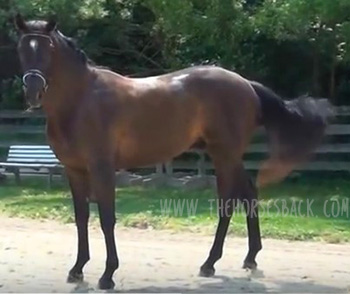
If you’re about to purchase a horse that falls into the ‘at risk’ category for this malformation, do your due diligence as a buyer, and have the caudal cervical vertebrae radiographed as part of your pre-purchase examination. A protocol for radiographing for the malformation is on this site.
The following papers also cover radiographs and CT imaging of the C6 malformation:
Ex Vivo Computated Tomographic Evaluation of Morphology Variations in Equine Cervical Vertebrae, Veraa, S. et al, Veterinary Radiology & Ultrasound, Vol. 57, Issue 5
Prevalence of Anatomical Variation of the Sixth Cervical Vertebra and Association with Vertebral Canal Stenosis and Articular Process Arthritis in the Horse,
Spriet, M. and M Aleman, Veterinary Radiology & Ultrasound, Vol. 57, Issue 3
If you wish to comment, please feel free to do so below, but please do so with respect for an owner who found herself in a nightmare situation. Alternatively, come over the blog’s discussion group on Facebook.
What a tragedy for you. You absolutely did the right thing.
Buyers beware.
I feel for you so much in what you have been through. I have also lost a very special horse so understand how gut wrenching it is, altho mine was not from this ailment. I have listened to Sharon on many occasions talking about this malformation, it has a mine field of contentious issues with it, and I applaud you going public.
Sorry to read of your horse’s plight. Just like so many things in life, you can have good luck or bad luck. I dare not think about how expensive it would be for a horse to have a thorough vet check prior to purchase.ama The list of things to look for would be endless.
I’m so sorry for your loss!
I also have a similar story. Five years ago I purchased a TB/ Warmblood for my teenage daughter to do Hunter/ Jumper with. We had a thorough vetting and the vet commented he had seldom seen such a clean vetting. 6 weeks later the horse began to stumble. Our trainer told my daughter she needed to use more leg. He began rooting out with his nose and became more difficult to collect. Next came the bucking outbursts. He was only 4, so it was put down to youth. Next came three tripping incidents with the last one resulting in him falling coming down from a jump and my daughter falling under him. I then took him to a vet clinic that had a neurologist and they diagnosed him. He is now turned out and does well except for the months of June and July when he is extremely lame.
That is so sad for all concerned. I hope your daughter wasn’t badly hurt?
If you feel OK to share, I’d be very interested to know whether your horse was radiographed and what the specifics were of that? I’m curious about the June and July lameness – do you know why that should occur during those months?
Having participated on a Sharon May-Davies whole horse dissection, this malformation was of great interest to me as an equine therapist.
However this saddens me so much, we, the people the owners are devastated to lose our young horses….BUT and it is a BIG BUT…..why oh why are we starting them so young.
The old horsemen didn’t start a horse until it was 4.
These big but fragile bodies cannot take the work that a lot of the trainers are throwing at the owner / rider ……please, please, please let them grow, be patient and don’t start them so early…maybe there would not be so much euthanasia if we did
Do you have documented evidence that horses were ever started later? Race horses have always run at 2, dating back into the 1800s. The race horse Polymelus was known to have this malformation and he raced as a 2 year old in the early 1900s. I think it is interesting to note that many of these horses raced longer distances, had longer careers and seemed to have less soundness issues than the horses we have today. Clearly they did not have access to the medications to keep them sound. Maybe we have begun to rely so much on medication that we are ignoring conformation faults when breeding. Maybe our desire to make horses that run faster and jump higher has contributed to more horses being retired at younger ages. It is sad whatever the reason.
First off I’m so sorry for the loss of your beloved partner. I know the pain that you went through and the questions that you had. The other night my horse, a 13 year old OTTB was just diagnosed with Wobbler Syndrome and a palpation of his neck showed he was very guarded of his C6 and C7. Right now it’s still way to soon for me to know anything further without radiographs. He started acting odd in his right back leg but then he was fine a few days later, right before Christmas I went to just ride around the arena when I got on him he stuck his back up into the saddle and held it there for quite a few mins. I got off and that was my last ride.
I have many mental snapshots over the past 5.5 year from his legs collapsing walking over ground poles, his front legs keep moving while his back legs stop moving, tripping alot, going belly up while playing in the feild, a fall he and I took that led to me getting my arm shattered (we where just walking). Almost everything in this article he has shown at least one. My horse as of the other night has been retired.
Thank you for sharing your story of your beloved animal, it did help when I had mine evaluated the other night, it dosent make it any easier but I was armed and ready to face the outcome.
Oh my I feel your pain. It was just suggested to me that this might be the source of ,my Wb/Tb gelding’s issues. He is 15. I’m just staring to learn about this. It’s been 3 year saga, progressively getting worse especially in the past 6 months. He was a lovely pleasure horse (like yours, winning a lot) and low level hunter. It started with an acute episode of Lyme for which he was successfully treated, then suddenly being unable to maintain his right lead behind ( he would swap only behind and only going right). It was intermittent at first. Another vet decided he had EPM, then I was told he had “neck issues” but treatments never resulted in improvement. We worked on some training methods, again without any consistent results then he started to become resistant to going out to the ring. This resistance became progressively MUCH worse, he wouldn’t even lead anywhere forward from the barn while under saddle he would only go backwards or up, anything but forward. I began to wonder if he was now just taking advantage of me. Finally a diagnosis of PSSM2; he is n/P2, n/Px. I never notice any true tie up episodes but he has lots of muscle tension. He’s become very anxious and randomly “spooky” and at times a little dangerous to handle if he doesn’t want to be led anywhere for ground work….I’m pretty much at my wits end….he’s most recently been seen twice by an osteopathic vet and she is suggesting neck and poll X-rays may be in order because his most significant issues are in his TMJ and poll area, just confirmed a couple of days ago by the equine dentist about a week after she did extensive work on those areas…this vet is now suggesting sending him for training…I refuse to do that thinking he is desperately trying to tell me that he IS IN PAIN!
I am looking at purchasing a 4-year-old warmblood. I had x-rays done of the horses’ neck and back. There is a small bone chip between C6 & 7 outside the spinal canal. I am wondering if someone has any experience with this?
Hi, thanks for asking your question here. Can I suggest a couple of FB groups where it might get a good response? There’s the group linked to this site – called The Horse’s Back Blog. Also, Horses and Neck Problems – you’ll find posts in a few different languages there. There’s a lot of knowledge out there – good luck on your search for more information.
I’m a bodyworker who has found neck, TMJ, hyoid, ligament and other problems over the years for their owners. In some cases, the owners had recently purchased the horse that “passed the vet” but something wasn’t right. So why not hire a good bodyworker to conduct a bodywork session of a potential new horse before taking the plunge? We have a different set of eyes and hands that can locate all kinds of things, especially in soft tissue. We’re a fraction of the cost of a vet’s PPE. Now I’m NOT suggesting bodyworkers should take the place of a veterinarian; we simply can complement the PPE process so that people have more information at hand to make a final decision to purchase or not. If I suspect anything going on I recommend the owner have a vet take radiographs or do an ultrasound.
I’m not commenting on you directly, but in the interests of discussion, wish to say that it’s such a tricky area.
I think we all have experiences of picking some things up, but, we don’t know about the things we’ve missed unless there’s a long term relationship with the client. There are liability issues here, not to mention that a missed condition could bring our reputations down through negative word of mouth.
With ECVM in younger horses, it may not be apparent anyway, as signs may only emerge at 8-12 years.
Increasingly, it’s becoming an issue of due diligence on the buyer’s part to have radiographs completed for high value horses or performance prospects, IF they can find a vet who will follow the recommended protocols…
Some studs are radiographing their breeding stock for ECVM and publishing results, so hopefully this practice will become more widespread.